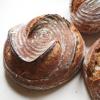
Semolina Filone (with a nod to Franko and dmsnyder)

I was traveling last week and when I returned home I needed a fix of bread baking. Since my starter needed to be refreshed and built up, I went for a poolish preferment, and Tom Cat's filone was high on my to-bake list. I read Franko's write up from last year, and he referred back to David's description from 2008, so I was prepared for a "pretty gloppy" dough. I closely followed the recipe from Glezer's "Artisan Baking" that David wrote up.
The dough was autolysed for 1 hour. Mixing the final dough, similar to what others described, I had to add quite a bit more flour. In fact, I increased the amount of flour by 25% (additional 75 gm per recipe) in order to get the dough to resemble anything like workable. However, after the third stretch & fold the gluten was very nicely developed and easy to work with. I made a double batch (because one loaf is never enough!) using Central Milling Extra Fancy Durum flour and a mixture of their Beehive AP and Hi Gluten flours. The dough gets very puffy and has to be handled very gently to retain the gas bubbles that develop. The results are worth it, with a beautiful golden crust, tremendous oven spring and fairly open crumb with holes of varying sizes throughout (including some large ones resulting from gentle shaping). And it is a flavorful loaf.

Here are a couple of observations: There may be an error in Glezer's recipe that resulted in the gloppy dough. The poolish calls for dissolving 1/4 tsp IDY in 1 cup of water, then using 1/4 c of this mixture plus 135 gm water and 150 gm flour. Here's the discrepancy: the listed baker's %-age for the water in the poolish is 110%, which would be 165 gm total. My measurement for the 1/4 c of yeast-water is 60-65 gm, and when added to the 135 gm of water, using the more conservative 60 gm, this comes to 130%. The leap of faith here is that the bakers %-age is more accurate than the ingredient measure. Given the consistency of the overly wet dough described by other TFL-ers, this 30 gm more water could account for it. I plan to make the bread again and will try this modified formula.
The second observation is that the amount of water used to autolyse the final dough was (in my case) not quite enough to hydrate all the flour. As pointed out in the book, it could be due to the freshness or the fineness of the durum flour, but because of the wet dough I didn't want to add more water. In retrospect, I should have. Next time I may steal a bit of water from the poolish and increase the amount in the final dough, keeping the overall hydration the same.
The crumb came out a bit too chewy for this type of bread. My wife loves this, but it needs to be toned down just a notch. I used the high gluten flour because I was concerned that there wouldn't be enough gluten if only AP was used, but that doesn't seem to be the case.
Lastly, the final proofing is really short. I proofed it about 45 minutes after shaping, and it seems a bit overproofed.


Happy Baking!
-Brad


Comments
Brad, That came out so well. I've made that too. It's a delicious bread. -Varda
Thanks Varda, it is quite delicious.
-Brad
Hi Brad,
Nice looking loaves you have there, well done! I agree with you that MG's formula is a little off with respect to the hydration method. Seems to me I relied more on her description (in italics) of how the dough should feel as well the %'s given than follow her process strictly during mixing. This bread has such a good flavour to it that goes with everything from sweet to savoury, it's one I should make more often. Thanks for the mention and linking to my post, much appreciated.
Best wishes,
Franko
Besides the taste, it's also a showy bread, from the huge oven spring to the butter-yellow crumb to the golden crust. I hadn't thought of serving it with sweet, but I bet it make a great french toast. Too bad that will have to wait until my next bake because it's all gone!
-Brad
And my recollection is that it does make very good French toast.
David